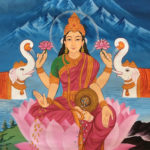The Principle of Feminine Divinity: Shaktism

India is a land not only of diversity but also of contradictions. If one can see diversity in almost every aspect of India, then one can also easily find contradictions in many of its traditions and belief systems.
In one of my earlier articles (An unacknowledged aberration), I discussed how, on the one hand, female deities are widely worshipped as the source of power and wisdom by Hindus in India. But on the other hand, women are maltreated or considered inferior, incapable and unintelligent. The widespread belief that power is feminine in nature but that the practice of looking down on women exists is not only contradictory but also hypocritical. In this article, I would like to elaborate on the religious tradition of Hinduism, which focuses on feminine power, thus providing an insight into the popularity and extensiveness of such a tradition.
One prominent tradition in Hinduism is that of “Shaktism”. “Shakti” means power or energy, and in the Shaktism tradition, power or energy is considered to be feminine in nature. Thus, according to the Shaktism tradition, the goddess is supreme as the metaphysical reality is feminine. Many different goddesses are worshipped by the followers of this tradition, and all the different goddesses are considered different aspects of the same supreme goddess. Moreover, different sub-traditions of the Shaktism tradition exist and are based on devotion to the particular goddess. Particularly important are two schools of practices, “Srikula” which is prominent in South India, and the other is “Kalikula” found in northern and eastern India.
The Srikula tradition of Shaktism views the goddesses as benign and beautiful and this view is prevalent in Andhra Pradesh, Kerela, Karnataka and Tamil Nadu. The Srikula tradition of Shaktism can also found in the Tamil areas of Sri Lanka. On the other hand, the Kalikula tradition of Shaktism focuses on the wrathful and ferocious aspect of a goddess. The Kalikula tradition is most dominant in Nepal and widely prevalent in the Indian states of West Bengal, Assam, Orissa, and Bihar, as well as in some parts of Maharashtra and Kerala. In fact, in the Kalikula tradition, the goddess or devi is considered the source of wisdom and liberation. The main deities of the Kalikula tradition are Kali, Durga, and Chandi, and other deities are Tara, Manasa (the snake goddess), Bhuvaneshwari, Bhairabhi to name but a few.
However, some deities are worshipped across the Indian subcontinent, though they might be addressed by different names in different states or communities. One such deity is the Goddess Lakshmi, who epitomizes fortune, wealth, abundance and prosperity. She is the wife of Lord Vishnu, the Supreme Being in the Vaishnavism tradition of Hinduism.
It is ironical that, in the ancient Indian scriptures of Hinduism, all women are considered embodiments of Goddess Lakshmi, but the treatment of women, in general, has been contrary to such understanding. Amongst Hindus, the women in a family are considered Lakshmi. She is expected to bring prosperity, happiness, and abundance in the home due to her benign nature and ability to nurture the bonds among family members.
Goddess Kali is revered as the destroyer of evil, and also worshipped as the Divine Mother and the ultimate reality of Brahman. She is considered to be the Divine Protector, who provides liberation from the cycle of birth and death. She is depicted as being black or blue in popular Indian art. Her eyes are described as red with intoxication, and in absolute rage, her hair is shown dishevelled, small fangs sometimes protrude out of her mouth, and her tongue is lolling. She is often shown naked or just wearing a skirt made of human arms and a garland of human heads. Although her appearance is wrathful, Kali is often considered to be the kindest and most loving of all the Hindu goddesses and is regarded by her devotees as the Mother of the whole Universe. And because of her ferocious form, she is also often seen as a great protector.
Shakta temples are found all over India as well as in South Asia. The important pilgrimage sites of “Shaktism” are called “Shakti Peeths”, which means “the Seats of the Devi (Goddess)”.
Shaktism has been dismissed many times as a superstitious, black magic-infested tradition that can hardly be qualified as a true religion. However, the worshipping of goddesses is very widespread in India.
Credits
| Image | Title | Author | License |
|---|---|---|---|
 |
Lakshmi- | Elisa Steininger | CC BY-SA 4.0 |
